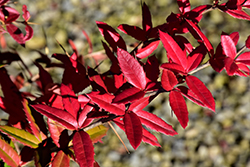Height: 6 feet
Spread: 8 feet
Sunlight:
![]()
![]()
Hardiness Zone: 5
Description:
A beautiful shrub that looks rich on the landscape; red emerging foliage matures to deep green all summer, finally turning wine red in fall, also has attractive flowers and inconspicuous dark fruit in the fall
Ornamental Features
Wintergreen Barberry has attractive dark green evergreen foliage which emerges red in spring on a plant with an upright spreading habit of growth. The glossy narrow leaves are highly ornamental and turn an outstanding burgundy in the fall, which persists throughout the winter. It is bathed in stunning clusters of fragrant yellow flowers hanging below the branches from early to mid spring. The fruits are showy plum purple drupes displayed from early to late fall.
Landscape Attributes
Wintergreen Barberry is a dense multi-stemmed evergreen shrub with an upright spreading habit of growth. Its relatively fine texture sets it apart from other landscape plants with less refined foliage.
This is a relatively low maintenance shrub, and usually looks its best without pruning, although it will tolerate pruning. Deer don't particularly care for this plant and will usually leave it alone in favor of tastier treats. Gardeners should be aware of the following characteristic(s) that may warrant special consideration;
- Spiny
Wintergreen Barberry is recommended for the following landscape applications;
- Accent
- Mass Planting
- Hedges/Screening
- General Garden Use
Planting & Growing
Wintergreen Barberry will grow to be about 6 feet tall at maturity, with a spread of 8 feet. It has a low canopy with a typical clearance of 2 feet from the ground, and is suitable for planting under power lines. It grows at a fast rate, and under ideal conditions can be expected to live for 40 years or more.
This shrub does best in full sun to partial shade. It is very adaptable to both dry and moist growing conditions, but will not tolerate any standing water. It is not particular as to soil type, but has a definite preference for acidic soils, and is able to handle environmental salt. It is highly tolerant of urban pollution and will even thrive in inner city environments. This particular variety is an interspecific hybrid.
